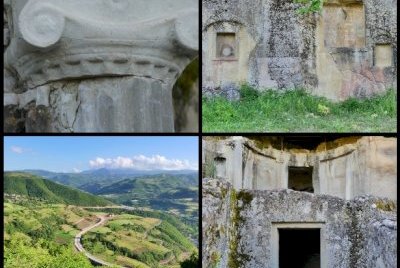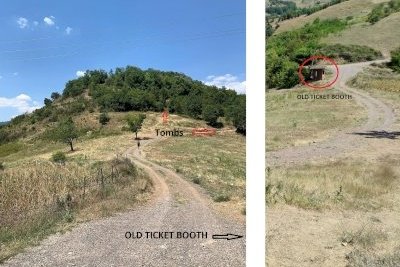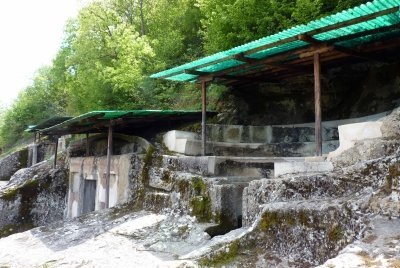Albania
Les tombes de la Basse Selca
The tombs of Basse Selca are remains of an Illyrian city that was a regional administrative and trade center. Five rock-cut, monumental royal tombs from the 4th-3rd century BC have been discovered. The graves held rich findings including weapons, bronze vessels, ceramics and gold jewellery.
Site Info
Official Information
- Full Name
- Les tombes de la Basse Selca (ID: 909)
- Country
- Albania
- Status
-
On tentative list 1996
Site history
History of Les tombes de la Basse Selca
- 1996: Added to Tentative List
- Added to tentative list
- Type
- Cultural
- Criteria
Links
- UNESCO
- whc.unesco.org
All Links
UNESCO.org
- whc.unesco.org — whc.unesco.org
Community Information
- Community Category
- Secular structure: Burial
Travel Information
Recent Connections
News
No news.
Community Reviews
Show full reviews
I visited this tWHS in Spring 2022 on a sunny day. The royal tombs of Selca e Poshtme are currently in a pityful state of conservation and access to the site is quite complicated and out of the way as "Gradishta e Selcës së Poshtëme" on Google Maps (not to be mistaken with nearby "Gredishtë".
Huge road works were underway when I visited so I had to drive for a good 10 km on a dusty main road in-the-making full of pot holes then a further 10 km through a narrow meandering tractor road up and down the hills of Albania. Unless things improve in the meantime, I would certainly keep away in rainy conditions. Even in sunny conditions, the 5 royal tombs are visitable on a short overgrown loop. There are a few columns, decorated and rock hewn niches, stone sarcofagi and eroded capitals but pretty much nothing more. The few temporary protection offered over some of the 5 royal tombs has corroded and/or collapsed and information boards are non-existent and the little restoration made has been done clumsily at best.
A better overview of the site and what has been found there can be had at the upper floor of the National Archaeological Museum in Tirana. There you will be able to understand how the previous regime attached great importance to this site and any ancient sites for political reasons. Ever since, the royal tombs of Selca e Poshtme have long been forgotten and if truth …
Keep reading 0 comments
There is not much that can be added to Solivagant's excellent review of les tombes de la Basse Selca in Albania. I will only give an update on how to get there and what to expect as of August 2022 when I visited the tombs on my way from Elbasan to Lin.
Now, the location is even mapped on google maps as "Gradishta e Selcës së Poshtëme" (coordinates: 40.990687532328295, 20.519241375903466). This is the correct position so it's a good way to find the right spot. Don't get confused with the nearby "Gredishtë" as it will lead you to the wrong spot.
A car is needed to get there. The tombs are in the middle of nowhere and there is no public transportation that could take you near enough.
I left the main road (E852/SH3) in Qukës and turned towards Karkavec. This road is either beeing built or being completely renovated. It is not paved and some parts, especially the beginning near Qukës, are in pretty bad conditions. The GPS told me that it would take 1 hour to reach the tombs from Qukës, however as I drove ahead, the road improved and it wasn't that bad after all.
After about 10 km and a steep uphill slope, you'll find a small country road on the left that looks pretty bad. This road, which leads to a group of houses called Lagja e Kumellarëve, is indeed very bad and completely unpaved, however, it can be done even …
Keep reading 0 comments
We visited “Les Tombes de la Basse Selca” in April 2018 following our decision to try to “fill in” all of Albania’s current T List, as well as its inscribed, sites. You will find it more normally titled “Royal Tombs of Selca e Poshtme”. It consists of a series of rock-cut tombs situated on a rocky “acropolis” in empty country behind Pogradec which date to c4th -3rd Century BC and belonged to the Illyrian royalty.
No, we didn’t know much about the Illyrians either and our “knowledge” of “Illyria” was limited to its occasional use as regional name across many historical periods in various areas of the Western Balkans! Wiki gives a quick overview. It is worth noting that the period of the tombs is contemporaneous with that of Philip II and Alexander the Great of Macedonia - Indeed in 358BC Philip II defeated the king of Illyria. A few searches will also identify that the ability to claim ancestry from the “Illyrians” is important to many “Albanians” and, to this day, plays a part in the relationships between Albania, Macedonia/FYROM, Serbia, Kosovo and Greece. The history and territory of these early Balkan tribes is not a “dead” issue! Have a read of “Who are the Illyrians? The Use and Abuse of Archaeology in the Construction of National and Trans-National Identities in the Southwestern Balkans” by Maja Gori if you want to know more!
Our trip there in our little rentacar was “problematic” mainly because the …
Keep reading 0 comments
